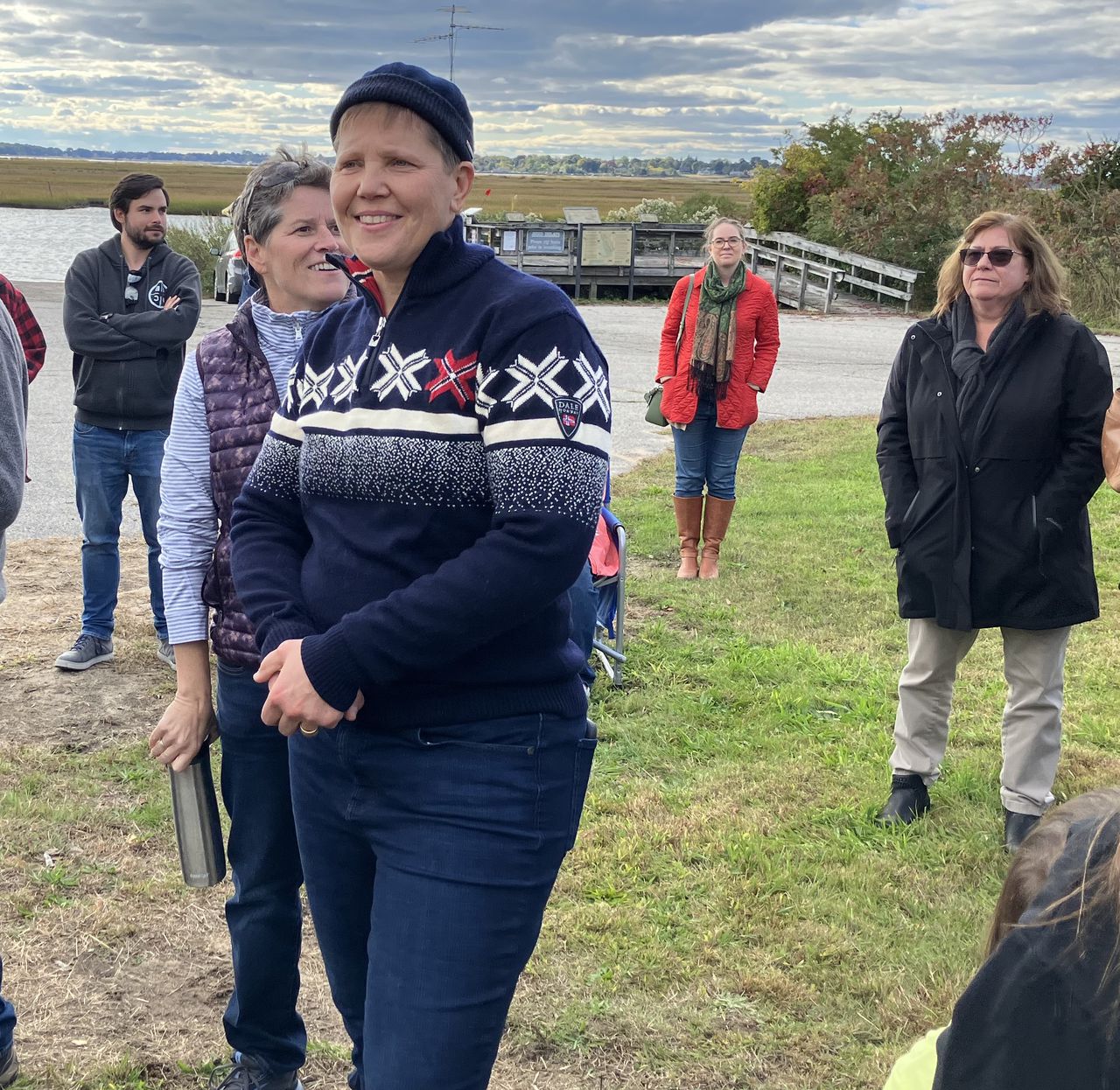OLD LYME, Conn. — When Kari Kastango waded out of the water at the Long Island Sound on Sunday she became the first known person to swim the entire the Connecticut River.
It took the South Hadley resident four years to cover all 410 miles or 2,164,800 feet of the river. She managed one swim in 47-degree water, planned around sewage overflow releases and figured her way around dams and other obstructions to reach her goal stroke by stroke.
Because of the tides and currents at the Long Island Sound, Kastango’s final swim of 2.6 miles took her 45 minutes, which was her second fastest. The quickest was an 11-mile trip that ended in Sunderland. It took two hours and eight minutes and was aided by a water release at the Turners Falls Dam, she said.
Swimming the Connecticut River wasn’t a feat Kastango, 56, had set out to do. She has loved the sport since she was about 10, but never swam competitively.
Kastango mostly grew up in the Massachusetts town of Holland and swam with her siblings at the reservoir there. She later graduated from the University of Massachusetts and received her doctorate from the University of Pittsburgh, and she now works as a director of statistical operations, analyzing data for medical research.
When she and her wife Alison Garvey moved to South Hadley a few years ago, Kastango couldn’t find a pond as she had in other Massachusetts towns where she lived. So she swam at the YMCA in Holyoke.
“I got tired of doing flip turns and a friend brought me to the Connecticut River to swim,” she said.
Kastango took her first swim in the river from Elwell Island in Northampton and to this day it continues to be one of her favorite parts of the river. Eventually, she wanted to try out other parts of the waterway.
Her desire to try other spots to swim led her to think she should just cover the entire river.
“At first I thought it was 200 miles. When I researched it I said, ‘Twice the size, twice the adventure,” Kastango said.
But many friends, family and others who gathered to celebrate her finish said her accomplishment is far more than an athletic feat.

Kari Kastango with her wife Alison Garvey behind her became the first person to swim the entire length of the Connecticut River on Sunday. (Jeanette DeForge/Republican staff)
Her finish highlights the change in the Connecticut River and the importance of the hundreds of millions of dollars of work communities up and down the river, including Holyoke, Chicopee and Springfield, have done to lessen sewage overflows and reduce pollution in the watershed, said Rebecca Todd, executive director of the Connecticut River Conservancy.
“It used to be fairly dreadful and we have seen marked improvements over the years in habitat returns and accessibility,” she said.
Kastango’s swim and the Western Massachusetts Ironman 70.3 triathlon held in June that included a 1.2-mile swim in the Connecticut River highlights the importance and the success of the cleanups, she said.
Members of the Friends of the Silvio O. Conte National Fish and Wildlife Refuge, which also oversees some of the watershed, also attended the celebration and asked people to help advocate for federal legislation they are hoping to pass to further preserve the river.
The Friends join together some 70 organizations big and small who work to support the river. It is currently promoting a bill that will create a partnership among governmental and private entities to promote conservation, education and preservation of the watershed, said Markell Smith, director of the organization.
To accomplish the swim, Kastango broke up the Connecticut River into sections and then swam, usually over the weekend, sometimes taking extra time off to get in an extra day during a nice period of weather. For safety, she was always accompanied by someone, often Garvey, in a kayak or canoe. Sometimes, she would stash her bicycle so she could ride back to her car when she was done.
Her first swims were in stretches she knew well in Western Massachusetts and Thompsonville, Connecticut where family lives. All the time she had to be mindful of heavy rains that could bring debris and sewer overflows making the water dangerous or unhealthy.
Along the way she received help from many people, including the Connecticut River Conservancy, of which she is now a board member.
Tim Lewis, who himself has paddled the 410 miles of the Connecticut River and knows multiple people who have also taken kayaks and canoes, became a close advisor when Kastango needed advice for sections in Connecticut, especially in areas affected by the tides from the connecting ocean.
“We were talking at one time and she said ‘I’m going to be a source to sea swimmer’ and I said I’m a source to sea paddler and she said, ‘Everybody paddles,’” Lewis joked.
Lewis realized the extra challenges a swimmer would face. A rock or log or debris would not hurt a paddler on the surface but could injure a swimmer, he said.
He also praised Kastango for her complete awareness of her surroundings, saying she will point out wildlife, trees and other things. “I will get reports from under the surface too… tire, fish, front end of a Ford pickup.”
When asked, Kastango said during her 410 miles of swims and training in the Connecticut River, she has spotted some spectacular wildlife: A deer with three fawns on Elwell Island, a duckling learning to swim with its mother and an endangered sturgeon.
For her finish, she wore a dry suit since the weather was hovering in the low 60s but she said the water was still comfortably warm.
“I swam for you, I swam for me but I also swam for the Connecticut River Conservancy as well as the beautiful wildlife that comes here,” Kastango said.
When asked what she would do next, one of her supporters joked she now should swim the river but backward — or upstream.
“I’m crazy not stupid,” she replied, laughing.
She said she has no great plans for another athletic feat but wants to keep her connection to the Connecticut River as a board member for the conservancy.
“I’m excited to do further work for the river so the energy that I put into this swim will now be directed toward initiatives that the conservancy has,” she said.
During every swim, Kastango wore seven Norwegian coins, which have a hole in the middle, strung on a silver chain around her neck in a nod to her mother, who was born in the country. She said she now plans to hand them out to people who are very important to her to serve as an inspiration.
She is also planning to get a great blue heron tattoo because on nearly every leg of her swim she would spot one flying overhead or along shore. At one time she slowed when she spotted one of the large birds fishing from the shore and was lucky enough to catch it spearing a minnow.
“Us being alive is a gift and having the Connecticut River and the tremendous diversity of wildlife and habitat here is a gift,” she said.





